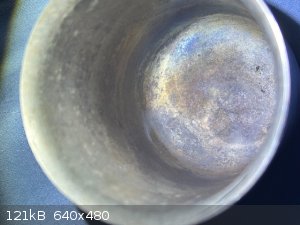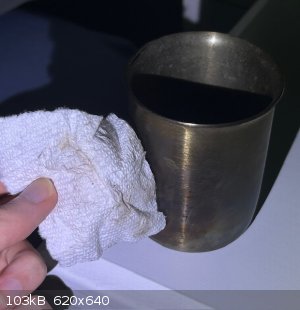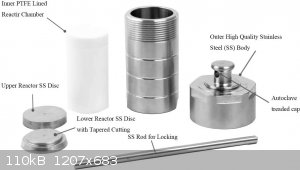dettoo456
Hazard to Others
  
Posts: 178
Registered: 12-9-2021
Member Is Offline
|
|
Stainless Steel Reaction Vessels
Does anyone use or have experience using stainless steel reaction vessels instead of glass? Obviously it’s used industrially over glass (or with in
glass-lined vessels) but I haven’t seen much amateur use. Even plastic bottles and weird stuff like old fire hydrants seem more commonly used than
normal stainless steel. It seems cheap (when bought used), nonmagnetic, less fragile, and pretty corrosion resistant except against halogens.
Borosilicate is universally resistant of course, but in some procedure like a nitration, extraction, reduction, or generally anything organic, 304 SS
seems like it’d be plainly better to work with.
Is there something obvious I missed about it?
[Edited on 1-2-2024 by dettoo456]
|
|
|
Sulaiman
International Hazard
    
Posts: 3561
Registered: 8-2-2015
Location: 3rd rock from the sun
Member Is Offline
|
|
The reason that I use mostly glass is....
I can watch what happens.
Interesting, educational, and I get some warning of impending disasters.
And it's cute 
PS as a boy dabbling with chemistry I wanted jointed glassware,
now, as a big boy, I can afford it.
But I may have over-compensated for my unfulfilled boyhood desires 
[Edited on 1-2-2024 by Sulaiman]
CAUTION : Hobby Chemist, not Professional or even Amateur
|
|
|
Rainwater
National Hazard
   
Posts: 800
Registered: 22-12-2021
Member Is Offline
Mood: indisposition to activity
|
|
your not alone.
I seen someone post a while back about some ss shot glasses. these have worked great for decomposition reactions for me. And are affordable.
They didnt hold up to well for molten salt(nacl,cacl mix) electrolysis because the outside started corroded due to air exposure, worked good as a
cathode and i did recover some sodium.
For molten or boiling down group 1 salts, that normally destroy glass, they work as expected, slight discoloration of the salt from chrome
contamination, but that is acceptable for my purpose. They can not be used with strong acids, so nitric and sulfuric are out. And i destroyed one
boiling down sodium acetate from solution containing a slight excess of vinegar
Edit:
This 30mL shotglass would work better than the stainless steel ones
[Edited on 1-2-2024 by Rainwater]
"You can't do that" - challenge accepted
|
|
|
charley1957
Hazard to Others
  
Posts: 137
Registered: 18-2-2012
Location: Texas
Member Is Offline
Mood: Extracted
|
|
I use stainless if I need to utilize really high temperatures, but often get a contamination from it as Rainwater noted. I try to use glass whenever
possible, but I do have a few assorted sizes of stainless bowls and cups for those times when I need the heat resistance.
You can’t claim you drank all day if you didn’t start early in the morning.
|
|
|
SnailsAttack
Hazard to Others
  
Posts: 163
Registered: 7-2-2022
Location: The bottom of Lake Ontario
Member Is Offline
|
|
I have a stainless steel beaker. It's only a year old but it looks like shit and I barely even use it.
  
I don't think I've even put a chloride salt in this thing and the interior's already completely dull. A fair amount of rust rubs off when wiped with a
paper towel, but nothing too crazy, to be fair.
I'd say it's probably useful for handling wet alkalis and maybe organics or fairly dry salts, but never wet chlorides or anything even remotely
acidic.
The nice thing about stainless steel is you don't have to worry about it randomly imploding on the stovetop the way you do with glassware; this thing
is virtually indestructible. Too bad it still tends to chip and flake off as it rusts.
|
|
|
SnailsAttack
Hazard to Others
  
Posts: 163
Registered: 7-2-2022
Location: The bottom of Lake Ontario
Member Is Offline
|
|
Oh these are perfect, I've been having to choose between the metal beaker I posted and a teeny little 30 mL cocktail shaker cap which is about ready
to crumble to dust.
|
|
|
Keras
National Hazard
   
Posts: 775
Registered: 20-8-2018
Location: (48, 2)
Member Is Offline
|
|
I was looking at some point to some sort of stainless steel round bottom flask to perform the thermal decarboxylation of sodium benzoate to benzene,
which was a crazy idea (the flask, not the reaction)
You can find bottles with GL45 threading, but they’re super expensive.
And in any case, it’s impossible to fit steel to glass because of the difference in thermal expansion coefficients…
|
|
|
zed
International Hazard
    
Posts: 2277
Registered: 6-9-2008
Location: Great State of Jefferson, City of Portland
Member Is Offline
Mood: Semi-repentant Sith Lord
|
|
Umm. Decarboxylation of Sodium Benzoate? Guys often use "tin" cans for this type reaction. Cheap! Easily replaceable! Empty (handheld) propane
torch cylinders might suffice. When they invariably corrode away; it is no big loss.
|
|
|
mr_bovinejony
Hazard to Others
  
Posts: 124
Registered: 20-4-2018
Member Is Offline
Mood: ASS
|
|
Recently I found a stainless steel pepper grinder that last 1 run at 900c with some ferrocyanide using a small clay pot to close the bottom. Is there
really no way besides welding to seal the threads of a stainless steel pipe and cap to withstand such high temperatures? Refractory cement may work
but having the chisel that crap off every time you open the cap would be a pain
Kf flanges can be used to go from steel to glass the connection would have to be far enough to be cool
BVV Stainless Steel KF-25 x Glass Jointed Adapter-24/40 https://a.co/d/iKBOr03
[Edited on 21-3-2024 by mr_bovinejony]
|
|
|
Keras
National Hazard
   
Posts: 775
Registered: 20-8-2018
Location: (48, 2)
Member Is Offline
|
|
Quote: Originally posted by zed  | | Umm. Decarboxylation of Sodium Benzoate? Guys often use "tin" cans for this type reaction. Cheap! Easily replaceable! Empty (handheld) propane
torch cylinders might suffice. When they invariably corrode away; it is no big loss. |
Yes, I know. I just happen to have none really available at hand at the time, and I was looking for a more ‘durable’ device.
|
|
|
Mateo_swe
National Hazard
   
Posts: 505
Registered: 24-8-2019
Location: Within EU
Member Is Offline
|
|
There are these "Hydrothermal Autoclave Reactor" made of stainless steel that is used for chemical reactions.
They are completely sealed and made up to withstand the pressures developing inside.
They usually have a PTFE jar inside that you put the reagents in and all this goes inside the SS vessel.
They are really nice but somewhat expensive.
One can use these instead of an autoclave in some applications.
But Borosilicate glass is easier and better for most situations.

|
|
|
Dr.Bob
International Hazard
    
Posts: 2660
Registered: 26-1-2011
Location: USA - NC
Member Is Offline
Mood: No Mood
|
|
I have used these "bomb" type reactors occasionally for years, always behind a shield, hence the name...
They are OK, but you can't see the reaction, it is hard to heat them in a simple manner, unless you buy a special heating mantle and controller rated
to high temps, and they corrode eventually. And the liners often warp or bend so that they are hard to use. But I have done reactions at many
atm in them. I usually start moderate (1/2 of rated pressure), then work my way up slowly. If your reaction generates a gas, like de-Boc'ing an
amine, they can be a mess, and build up pressure very fast once a reaction starts, or if it is auto-catalytic. Again, use a shield...
For slightly high pressure reactions, I prefer glass pressure tubes (like from Ace) or even better, disposable microwave tubes with crimp caps, like
CEM or Biotage has used. Both have fancier caps now, but the old crimp top ones were the bomb... I often use them outside of a microwave, in
oil baths or other heating methods, again, always behind a shield, just in case. I could do 140C reactions in EtOH and isoPrOH with those, and
similar reactions. Much easier than setting up a reflux condenser, and reactions go faster at higher temps. But always some danger. Maybe that
is why people like them. For low pressure reactions, I often use septa top vials and heat just to the BP, which works fine, and normally does not
build up enough pressure to pop the septa top, but that acts as a pressure limiting device as well.
I have only blown up a few vials in the microwave or vials. But use some sense, heating K2CO3 in acid in a sealed tube is not a good idea, and many
other things I have seen people do. Heating organics in air or oxygen also is not so wise... Best to blow out with nitrogen.
|
|
|
ManyInterests
National Hazard
   
Posts: 843
Registered: 19-5-2019
Member Is Offline
|
|
I'm not sure about reaction vessels, but I did make ammonium nitrate from calcium nitrate (via ammonium carbonate) in a copper lined dutch oven
without issue. Did the same with my stainless steel dutch oven.
Now I only use that to boil down my nitrates out of solution. I never saw any degradation of my product as a result.
| Quote: | | I have only blown up a few vials in the microwave or vials. But use some sense, heating K2CO3 in acid in a sealed tube is not a good idea, and many
other things I have seen people do. Heating organics in air or oxygen also is not so wise... Best to blow out with nitrogen. |
Yeah don't do that. I tried to heat up KNO3 in water in my microwave and... yeah, I had a bad feeling and I stopped before anything happened.
|
|
|
BromicAcid
International Hazard
    
Posts: 3227
Registered: 13-7-2003
Location: Wisconsin
Member Is Offline
Mood: Rock n' Roll
|
|
My work has been trying to swap over to stainless flasks for use with pyrophorics for safety sake. They are shaped just like a regular 22L, 50 L, 72L
flask but have KF glassware joints which are a kind of flat face joint with a gasket and clamp. We have regular flasks with the same joints too. One
of the necks usually has a glass viewing window installed and if there is a free joint after everything else is hooked up a second will usually be
setup with a glass window so you can shine the flashlight through that one and look through the other as a view port. They work fine, not sure I've
noticed better thermal conductivity despite the fact that you would expect it.
|
|
|
dettoo456
Hazard to Others
  
Posts: 178
Registered: 12-9-2021
Member Is Offline
|
|
Quote: Originally posted by BromicAcid  | | My work has been trying to swap over to stainless flasks for use with pyrophorics for safety sake. They are shaped just like a regular 22L, 50 L, 72L
flask but have KF glassware joints which are a kind of flat face joint with a gasket and clamp. We have regular flasks with the same joints too. One
of the necks usually has a glass viewing window installed and if there is a free joint after everything else is hooked up a second will usually be
setup with a glass window so you can shine the flashlight through that one and look through the other as a view port. They work fine, not sure I've
noticed better thermal conductivity despite the fact that you would expect it. |
Do you know if they have pressure relief valves (or purges for pyrophorics) on all those steel reactors too?
Especially if using glass pressure vessels w/ Ace threads, taking up a joint with a relief valve seems like a no-brainer, at least for peace of mind.
|
|
|
BromicAcid
International Hazard
    
Posts: 3227
Registered: 13-7-2003
Location: Wisconsin
Member Is Offline
Mood: Rock n' Roll
|
|
Quote: Originally posted by dettoo456  |
Do you know if they have pressure relief valves (or purges for pyrophorics) on all those steel reactors too?
Especially if using glass pressure vessels w/ Ace threads, taking up a joint with a relief valve seems like a no-brainer, at least for peace of mind.
|
Yeah, one of the necks is a burst disk, they're appropriately sized by the engineers based on the size of the vessel and they blow out into an inerted
container.
|
|
|
Grizli7
Harmless

Posts: 40
Registered: 1-9-2021
Member Is Offline
|
|
First, you need to decide on the reactions that you will carry out and only then select/make stainless steel equipment. Glass is glass. Stainless
steel is stainless steel.
|
|
|